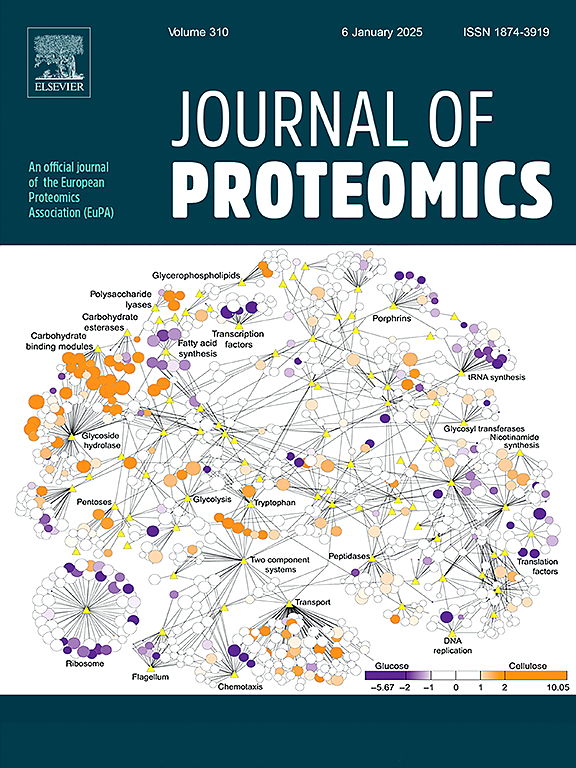揭示红肉苹果的蛋白质组学景观,以确定花青素积累的调节因子
IF 2.8
2区 生物学
Q2 BIOCHEMICAL RESEARCH METHODS
引用次数: 0
摘要
花青素是一种具有抗氧化特性的彩色植物色素,富含这些类黄酮的饮食对健康有益。因此,在可食用的植物部位积累大量的花青素是有意义的,在驯化的苹果Malus domestica中,某些红肉苹果品种表现出这种特性。苹果果肉中花青素积累的增强是由于MYB转录因子MdMYB10的过度激活,该因子通过诱导多种生物合成基因的表达,作为花青素生物合成的关键调节因子。虽然一些研究已经探索了潜在的基因突变和由此产生的转录组变化,但缺乏对导致红肉苹果表型的蛋白质组改变的研究。为了解决这一差距,采用了基于质谱的蛋白质组学方法。比较蛋白质组学鉴定出红肉品种“Bay13645”和白肉品种“Gala”的幼果和成熟果实中蛋白质含量存在差异。虽然MYB转录因子在果实发育早期富集,但在红肉基因型成熟果实中,它们不再是超丰富的蛋白质。相比之下,花青素生物合成酶在红肉品种的成熟果实中富集更强,支持了先前的研究结果,即色素沉着过程的控制存在发育阶段特异性差异。蛋白质组学方法还发现了可能导致红肉苹果表型的新调控因子和酶,包括BAHD酰基转移酶、Mal d蛋白和不同家族的转录因子,并讨论了它们与这一性状表现的潜在相关性。意义本研究为揭示红肉苹果花青素积累的分子机制提供了新的思路。利用基于质谱的蛋白质组学策略,该研究揭示了水果发育过程中蛋白质组学的改变是家苹果红肉表型的基础。值得注意的是,花青素生物合成的关键酶明显上调,强调了它们在苹果果肉色素沉着中的作用。重要的是,该研究还鉴定了以前未表征的蛋白质,包括BAHD酰基转移酶和一系列转录因子,为花青素积累的调控网络提供了新的视角。这些发现极大地扩展了我们对水果色素沉着代谢途径的理解,并为有针对性的作物改良开辟了有希望的途径。本文章由计算机程序翻译,如有差异,请以英文原文为准。

Unraveling the proteomic landscape of red-fleshed apples to identify regulators of anthocyanin accumulation
Anthocyanins are colorful plant pigments with antioxidant properties, and a diet rich in these flavonoids bears health benefits. Therefore, a strong anthocyanin accumulation in edible plant parts is of significant interest, and in Malus domestica, the domesticated apple, certain red-fleshed apple varieties exhibit this trait. Enhanced anthocyanin accumulation in the flesh of apple fruits is attributed to the hyperactivation of the MYB transcription factor MdMYB10, which acts as a key regulator of anthocyanin biosynthesis by inducing the expression of multiple biosynthetic genes. While several studies have explored the underlying genetic mutations and resulting transcriptome changes, there is a lack of research on proteome alterations that cause the red-fleshed apple phenotype. To address this gap, a mass spectrometry-based proteomics approach was employed. Comparative proteomics identified differentially abundant proteins in young and mature fruits of the red-fleshed ‘Bay13645’ variety compared to the white-fleshed ‘Gala’. Whereas several MYB transcription factors were enriched during early fruit development, they were no longer among the hyper-abundant proteins in ripe fruits of the red-fleshed genotype. In contrast, anthocyanin biosynthetic enzymes were enriched more strongly in ripe fruits of the red-fleshed cultivar, supporting previous results which had indicated developmental stage-specific differences in the control of the pigmentation process. The proteomic approach also identified novel regulatory factors and enzymes that may contribute to the red-fleshed apple phenotype, including a BAHD acyltransferase, Mal d proteins, and transcription factors of diverse families, and their potential relevance for the exhibition of this trait is discussed.
Significance
This study offers insights into the molecular mechanisms driving anthocyanin accumulation in red-fleshed apples. Utilizing a mass spectrometry-based proteomics strategy, the study reveals proteome alterations during fruit development that underlie the red-fleshed phenotype in Malus domestica. Notably, key enzymes of anthocyanin biosynthesis were markedly upregulated, underscoring their role in the pigmentation of the apple fruit pulp. Importantly, the study also identifies previously uncharacterized proteins, including a BAHD acyltransferase and a suite of transcription factors, shedding new light on the regulatory network orchestrating anthocyanin accumulation. These findings significantly expand our understanding of metabolic pathways that contribute to fruit pigmentation and open promising avenues for targeted crop improvement.
求助全文
通过发布文献求助,成功后即可免费获取论文全文。
去求助
来源期刊

Journal of proteomics
生物-生化研究方法
CiteScore
7.10
自引率
3.00%
发文量
227
审稿时长
73 days
期刊介绍:
Journal of Proteomics is aimed at protein scientists and analytical chemists in the field of proteomics, biomarker discovery, protein analytics, plant proteomics, microbial and animal proteomics, human studies, tissue imaging by mass spectrometry, non-conventional and non-model organism proteomics, and protein bioinformatics. The journal welcomes papers in new and upcoming areas such as metabolomics, genomics, systems biology, toxicogenomics, pharmacoproteomics.
Journal of Proteomics unifies both fundamental scientists and clinicians, and includes translational research. Suggestions for reviews, webinars and thematic issues are welcome.
 求助内容:
求助内容: 应助结果提醒方式:
应助结果提醒方式:


